| One Yen Banknote (Yen 1) Valid, But it doesn't circulate. | |
Obverse: Portrait of Ninomiya Sontoku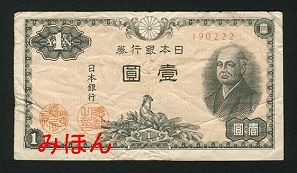
|
Reverse: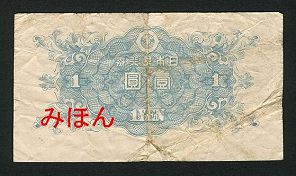
|
|
Size: 68mm X 124mm, Date of first issue: March, 1946 (Showa era, year 21) , Issue: Bank of Japan (NIPPON GINKO) Ninomiya Kinjiro (Ninomiya Sontoku, 1787-1856) was a prominent 19th century Japanese agricultural leader who was born to a poor peasant family but became a great landowner and aid to the bakufu and daimyo. In Japan, he is still a symbol of hard work and perseverance today. Born in a poor farmer family with a name of Kinjiro, Sontoku studied on his own as he worked hard for his family. A name Sontoku was given to him for his accomplishment. Later in his life was recruited by various daimyo to run village restoration projects. He is generally regarded even to this day as a symbol of hardwork and perseverance. |
|
| Five Yen Banknote (Yen 5) Valid, But it doesn't circulate. | |
Obverse: Guilloche pattern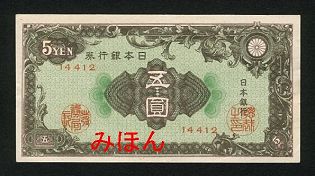
|
Reverse: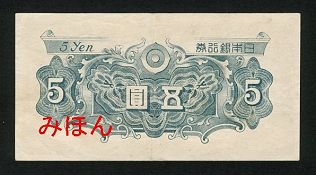
|
|
Size: 68mm X 132mm, Date of first issue: March, 1946 (Showa era, year 21), Issue: Bank of Japan (NIPPON GINKO) |
|
| Ten Yen Banknote (Yen 10) Valid, But it doesn't circulate. | |
|
Obverse: The Diet Building (left side) and Chinese phoenix (right side) 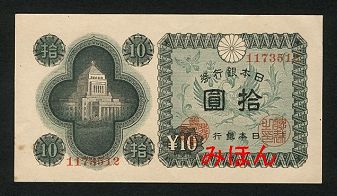
|
Reverse: 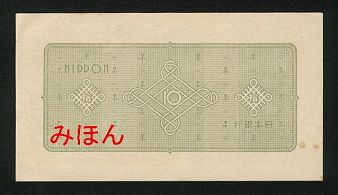
|
|
Size: 76mm X 140mm, Date of first issue: February, 1946 (Showa era, year 21), Issue: Bank of Japan (NIPPON GINKO) The National Diet Building (Kokkai-gijido) is the place in which both the houses of the Diet of Japan are held. It is located in 1-chome, Nagatacho, Chiyoda Ward, Tokyo. Sessions of the House of Representatives take place in the left side and sessions of the House of Councillors in the right side. The construction of the building began in 1920 and completed in 1936. Fenghuang (Japanese: hoo) are a species of mythological Chinese birds that reign over all other birds. The males are called feng and the females huang. In modern times, however, such a distinction of gender is often no longer made and the feng and huang are blurred into a single feminine entity so that the bird can be paired with the Chinese dragon, which has male connotations. The fenghuang is also called the August Rooster. In the West, it is commonly referred to as the Chinese phoenix. |
|
| One hundred Yen Banknote (Yen 100) Valid, But it doesn't circulate. | |
Obverse: Portrait of Itagaki Taisuke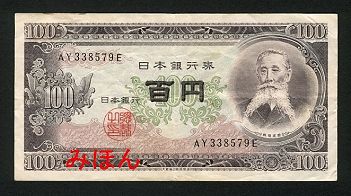
|
Reverse: The Diet Building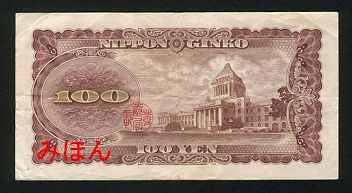
|
|
Size: 76mm X 148mm, Date of first issue: December, 1953 (Showa era, year 28), Issue: Bank of Japan (NIPPON GINKO) Itagaki Taisuke (1837 - 1919) was a Japanese politician who became a leader of the Freedom and People's Rights Movement (jiyu minken undo). |
|
| One Thousand Yen Banknote (Yen 1000) Series D | |
Obverse: Portrait of Natsume Souseki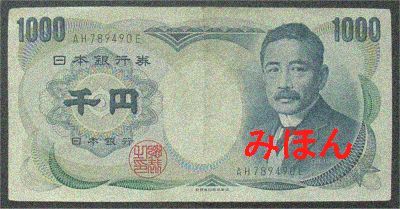
|
Reverse: A pair of cranes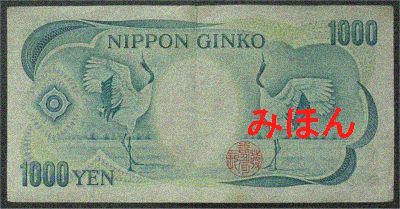
|
|
Size: 150X76mm, Date of first issue: Nov. 1, 1984, Issue: Bank of Japan (NIPPON GINKO) Natsume Soseki (February 9, 1867 - 1916) was the pen-name of Natsume Kinnosuke , who is widely considered to be the foremost Japanese novelist of the Meiji Era. He is best known for his novels Kokoro and Waga hai wa neko dearuu (I Am a Cat) . He was also a scholar of British literature and composer of haiku, Chinese-style poetry, and fairy tales. From 1984 until 2004, his portrait appeared on the front of the 1000 yen note. |
|
| One Thousand Yen Banknote (Yen 1000) Series E - Newest Japan Banknotes (2004) - | |
Obverse: Portrait of Dr. Noguchi Hideyo (1876-1928)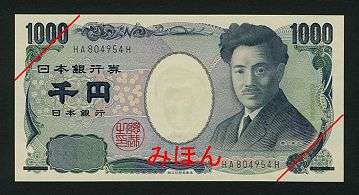
|
Reverse: Mt.Fuji and cherry blossoms. Cherry blossoms is JAPAN national flower.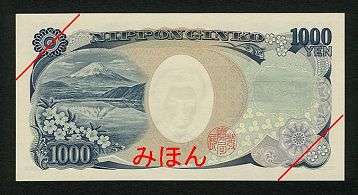
|
|
Size: 150X76mm, Date of first issue: Nov. 1, 2004, Issue: Bank of Japan (NIPPON GINKO) Noguchi Hideyo (November 9, 1876 - May 21, 1928) was a prominent Japanese bacteriologist who discovered the agent of syphilis disease in 1911. His portrait has been printed on Japanese 1000 yen bill since 2004. |
|
| Two Thousand Yen Banknote (Yen 2000) Series D | |
Obverse: Design of Shurei-mon Gate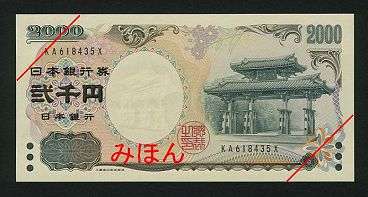
|
Reverse: A scene from the Tale of Genji, And portrait of its author, Murasaki Shikibu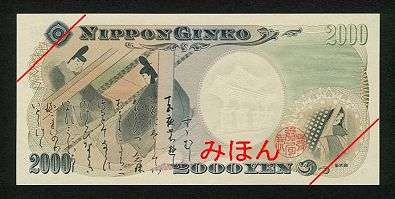
|
|
Size: 154X76mm, Date of first issue: Jul. 19, 2000, Issue: Bank of Japan (NIPPON GINKO) |
|
| Five Thousand Yen Banknote (Yen 5000) Series D | |
Obverse: Nitobe Inazo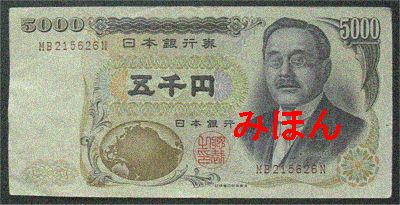
|
Reverse: Mt. Fuji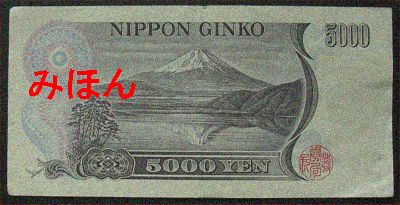
|
|
Size: 155X76mm, Date of first issue: Nov. 1, 1984, Issue: Bank of Japan (NIPPON GINKO) Nitobe Inazo (September 1, 1862 - October 15, 1933) was a Christian Japanese agriculturist, philosopher, educator and international political activist from Morioka, Iwate. Nitobe was in the third class of the Sapporo Agricultural Institute and was no doubt influenced by the teachings of Dr. William S. Clark, though they never crossed paths. He was a vice-minister of the League of Nations. He was the initiator of the Tokyo Women's Christian University. He is known as an author of Bushido: The Soul of Japan, a book on Christianity and Japan, and Be Just and Fear Not, a book of calligraphy. He advocated a precept calling for Christianity to be grafted onto the trunk of Bushido. He was a portrait on the 5000 Yen banknote printed from 1984 to 2004. |
|
| Five Thousand Yen Banknote (Yen 5000) Series E - Newest Japan Banknotes (2004) - | |
Obverse: Portrait: Higuchi Ichiyo (1872-1896)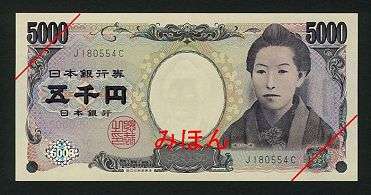
|
Reverse: "Kakitsubata-zu" (painting of irises) Work of Korin Ogata 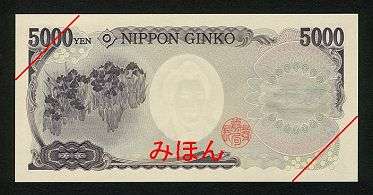
|
|
Size: 156X76mm, Date of first issue: Nov. 1, 2004, Issue: Bank of Japan (NIPPON GINKO) Higuchi Ichiyo (May 2, 1872 - November 23, 1896) is the pen name of the Japanese author Higuchi Natsu . At the age of 20, Higuchi wrote her first novel and also adopted the pen name of Ichiyo. Around this time, Higuchi turned down a marriage proposal (which likely would have signalled the end of her writing career) and moved to a house near the Yoshiwara pleasure quarters. In 1894 her first major work, Otsugomori was published, and in the following year, Takekurabe, Nigorie , and Jyusanya were published to critical and popular success. Higuchi's likeness adorns the Japanese 5000 yen note as of the Fall of 2004, becoming the third female to appear on a Japanese banknote, after Empress Jingu in 1881, and Murasaki Shikibu in 2000. Next to Jingu, she is the second woman to be featured prominently on a Japanese banknote. |
|
| Ten Thousand Yen Banknote (Yen 10000) Series D-Brown | |
Obverse: Portrait of Fukuzawa Yukichi (1835-1901)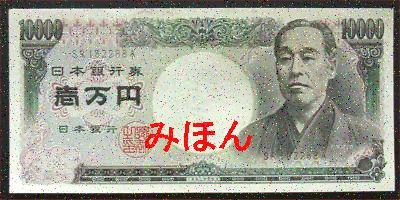
|
Reverse: A pair of pheasants. Pheasant is JAPAN national bird.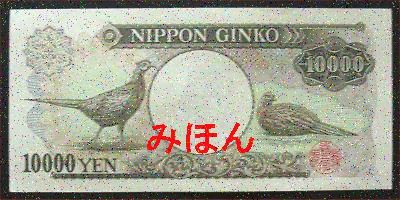
|
|
Size: 160X76mm, Date of first issue for brown serial number: Dec. 1, 1993, Issue: Bank of Japan (NIPPON GINKO) Fukuzawa Yukichi (January 10, 1835 - February 3, 1901) was an author, motivational speaker, and political theorist whose enlightened ideas about government and social institutions made a lasting impression on a rapidly changing Japan during the period known as the Meiji Era. |
|
| Ten Thousand Yen Banknote (Yen 10000) Series E - Newest Japan Banknotes (2004) - | |
Obverse: Portrait of Fukuzawa Yukichi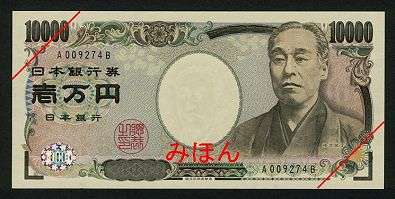
|
Reverse: Statue of Phoenix in Byodoin Temple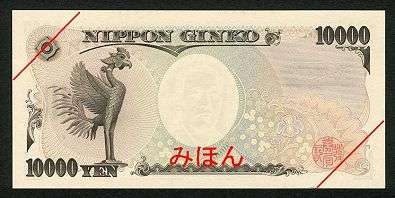
|
|
Size: 160X76mm, Date of first issue: Nov. 1, 2004, Issue: Bank of Japan (NIPPON GINKO) |
|
Contents related to in site
 |